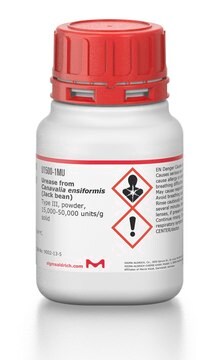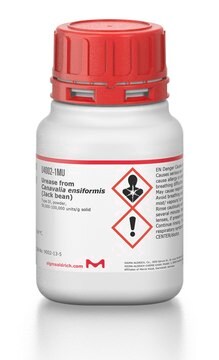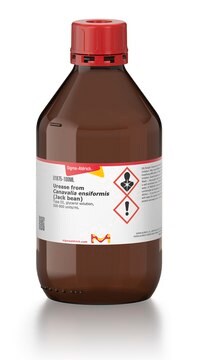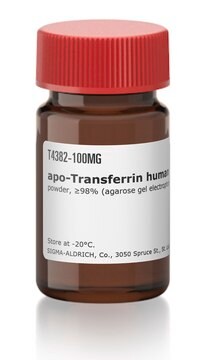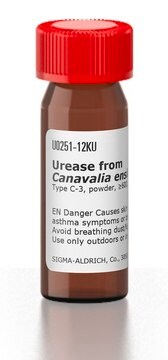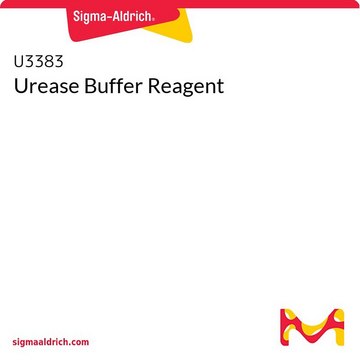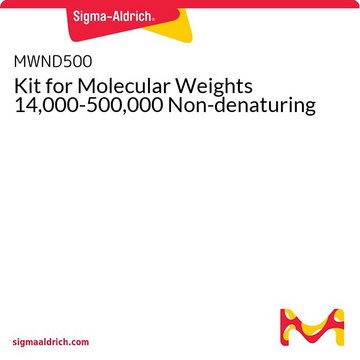Recommended Products
biological source
Canavalia ensiformis
Quality Level
form
solid
mol wt
hexamer 545 kDa
trimer ~272 kDa
contains
~20% dithiothreitol
suitability
suitable for marker for electrophoresis (non-denaturing PAGE)
storage temp.
−20°C
Looking for similar products? Visit Product Comparison Guide
General description
Subunit molecular weight: ~90,770
Composed of six subunits with total molecular weight: ~544,620
Composed of six subunits with total molecular weight: ~544,620
Urease is a multi-subunit nickel-dependent metalloenzyme. It is found abundantly in fungi, yeast, plants, and bacteria. It belongs to the superfamily of amidohydrolases and phosphotriesterases. Urease is also found in leguminous seeds.
Application
Urease from Canavalia ensiformis (Jack bean) has been used:
- as a component of the molecular mass standard in electrophoresis
- as a component of the standard in size-exclusion chromatography
- as a reference in native-polyacrylamide gel electrophoresis (PAGE)
Biochem/physiol Actions
Urease is an essential enzyme of the nitrogen cycle. It plays a role in degrading urea into ammonia and carbamate. Urease provides a source of nitrogen for growth to various organisms. It also plays a major role in seed germination and seed chemical defense.
Other Notes
Contains approx. 1 mg protein
Signal Word
Danger
Hazard Statements
Precautionary Statements
Hazard Classifications
Eye Irrit. 2 - Resp. Sens. 1 - Skin Irrit. 2 - STOT SE 3
Target Organs
Respiratory system
Storage Class Code
11 - Combustible Solids
WGK
WGK 1
Certificates of Analysis (COA)
Search for Certificates of Analysis (COA) by entering the products Lot/Batch Number. Lot and Batch Numbers can be found on a product’s label following the words ‘Lot’ or ‘Batch’.
Already Own This Product?
Find documentation for the products that you have recently purchased in the Document Library.
Customers Also Viewed
Muhammad Ajmal Rana et al.
PloS one, 16(10), e0258568-e0258568 (2021-10-15)
Urea is the most popular and widely used nitrogenous fertilizer. High soil urease activity rapidly hydrolyses applied urea to ammonia which contributes to soil nitrogen (N) losses and reduces N use efficiency of crop plants. The ammonia losses can be
Anuradha Balasubramanian et al.
Journal of molecular biology, 400(3), 274-283 (2010-05-18)
Urease, a nickel-dependent metalloenzyme, is synthesized by plants, some bacteria, and fungi. It catalyzes the hydrolysis of urea into ammonia and carbon dioxide. Although the amino acid sequences of plant and bacterial ureases are closely related, some biological activities differ
Prevention of infected urinary stones by urease inhibition.
D P Griffith et al.
Investigative urology, 11(3), 228-233 (1973-11-01)
Paweł Kafarski et al.
Journal of advanced research, 13, 101-112 (2018-08-11)
Urease is a nickel-dependent metalloenzyme found in plants, some bacteria, and fungi. Bacterial enzyme is of special importance since it has been demonstrated as a potent virulence factor for some species. Especially it is central to Helicobacter pylori metabolism and
Suchithra Menon et al.
Cell, 156(4), 771-785 (2014-02-18)
mTORC1 promotes cell growth in response to nutrients and growth factors. Insulin activates mTORC1 through the PI3K-Akt pathway, which inhibits the TSC1-TSC2-TBC1D7 complex (the TSC complex) to turn on Rheb, an essential activator of mTORC1. However, the mechanistic basis of how
Our team of scientists has experience in all areas of research including Life Science, Material Science, Chemical Synthesis, Chromatography, Analytical and many others.
Contact Technical Service